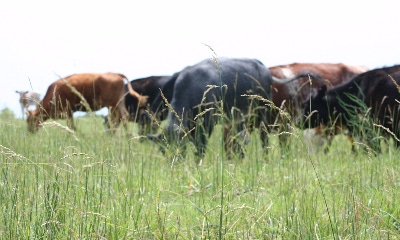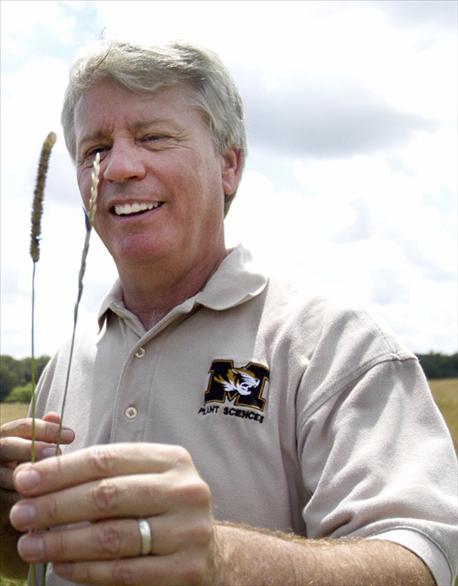March 22, 2016

Nitrogen makes grass grow. Spreading fertility produces more pounds of forage, which cows convert to protein: beef and milk.
Adding nitrogen to pastures would be a no-brainer, except for some Missouri farms have toxic tall fescue.
"I get lots of calls in spring asking how much nitrogen to add per acre," says Craig Roberts, University of Missouri Extension forage specialist.
Roberts responds with two questions in order to help farmers determine if nitrogen is right for their pastures:
1. What kind of grass? "If they say Kentucky 31 toxic fescue," Roberts notes, "I say 'Hold back.' If it is a novel-endophyte fescue, I say 'How much can you afford?'"

USE CAUTION: Nitrogen can help grow grass in pastures, but it can also increase toxins in certain fescue fields harming cattle.
Yes, nitrogen boosts grass yields, but fertility also feeds a toxic fungus living unseen between plant cells of K-31 fescue. With added fertilizer, the endophyte fungus makes more toxic alkaloids that harm cattle.
Ergovaline is the long-unknown compound that has cost grass farmers millions of dollars a year. Toxic fescue cuts conception rates, milk output and pounds of gain. It affects heat tolerance. Also, the toxin constricts blood flow.
That latter symptom can cause fescue foot, which can kill cows.
Novel-endophyte fescues have a nontoxic fungus. Replacing toxic fescue pasture proves a cure for many problems caused by grazing K-31 fescue, Roberts says.
2. When do you plan to apply nitrogen? If you plan to harvest hay, an early spring treatment adds yields. However, you must consider whether you can cut the hay early enough to make quality hay. Hay must be cut before seed heads emerge.
If rains delay harvest, K-31 fescue shoots up seed heads that contain the toxin. Also, the late cut grass is overmature, losing nutrients.

Craig Roberts
Late-baled hay becomes both toxic and lacking in nutrients. Not fertilizing toxic hay is one workaround to prevent toxicosis.
Fescue has two surges of growth. About two-thirds of the annual forage growth comes in the spring. One-third of the grass grows after September rains start. Nitrogen applied in August boosts autumn grass growth. That smooths out the annual distribution of forage.
The summer slump in forage can be filled by grazing clovers interseeded in fescue. A big application of nitrogen in spring causes grass growth to crowd out the legumes. If left unfertilized, legumes fix free nitrogen that is shared with nearby grass.
~~~PAGE_BREAK_HERE~~~
Understand how nitrogen works in your pasture
Nitrogen, a key fertility in grazing systems, is a basic building block for protein made by grass and eaten by cattle.
Nitrogen is easily lost. Much of the phosphorus and potassium are passed through the grazing livestock. With managed grazing, the cattle evenly distribute their manure over pasture paddocks. That reduces need to buy those fertilizers.
Nitrogen increases growth of the fungus growing between cell walls of K-31 fescue. It's a symbiotic growth; both need each other. The grass provides nutrients to the fungus. The fungus gives the plant protection with the toxic alkaloids.
Cattle grazing infected fescue back off to reduce their intake. Also, with heat stress, they go to the shade or stand in ponds to cool off. That reduces grazing times.
This lowers daily gain of beef.
Three schools are open to teach management of toxic fescue. The best way is replacing toxic fescue with the new novel-endophyte fescues.
Schools will be March 28, Welch, Okla.; March 29, Mount Vernon, Mo.; and March 30, Columbia, Mo. Details, agenda and sign-up are at the Alliance for Grassland Renewal.
Source: University of Missouri Extension
You May Also Like




